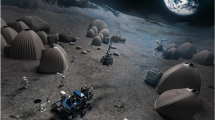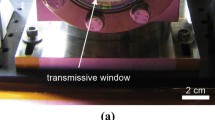Abstract
Aiming at the exploration and resource utilization activities on the Moon, in situ resource utilization and in situ manufacturing are proposed to minimize the dependence on the ground transportation supplies. In this paper, a laser-assisted additive manufacturing process is developed to fabricate lunar regolith composites with PA12/SiO2 mixing powders. The process parameters and composite material compositions are optimized in an appropriate range through orthogonal experiments to establish the relationship of process—structure—property for lunar regolith composites. The optimal combination of composite material compositions and process parameters are mixing ratio of 50/50 in volume, laser power of 30 W, scanning speed of 3500 mm/s, and scanning hatch space of 0.2 mm. The maximum tensile strength of lunar regolith composites reaches 9.248 MPa, and the maximum depth of surface variation is 120.79 µm, which indicates poor powder fusion and sintering quality. Thereafter, the mechanical properties of laser-sintered lunar regolith composites are implemented to the topology optimization design of complex structures. The effectiveness and the feasibility of this laser-assisted process are potentially developed for future lightweight design and manufacturing of the solar panel installed on the lunar rover.

Similar content being viewed by others
Abbreviations
- AM:
-
Additive manufacturing
- CAD:
-
Computer-aided design
- DIC:
-
Digital image correlation
- DLP:
-
Digital light processing
- DSC:
-
Differential scanning calorimetry
- DTG:
-
Differential thermogravimetry
- ESA:
-
European Space Agency
- SEM:
-
Scanning electron microscope
- SLS:
-
Selective laser sintering
- STA:
-
Synchronous thermal analyzer
- TGA:
-
Thermogravimetric analysis
- F :
-
External force loading on the structure
- h :
-
Hatch space
- p :
-
Laser power
- r :
-
Mixing ratio
- R :
-
Influence degree of corresponding factors
- T m :
-
Melting peak temperature
- T r :
-
Recrystallization peak temperature
- v :
-
Scanning speed
References
Wu W R, Liu W W, Qiao D, Jie D G. Investigation on the development of deep space exploration. Science China Technological Sciences, 2012, 55(4): 1086–1091
Xu L, Zou Y L, Jia Y Z. China’s planning for deep space exploration and lunar exploration before 2030. Chinese Journal of Space Science, 2018, 38(5): 591–592
Howell J T, Fikes J C, McLemore C A, Good J E. On-site fabrication infrastructure to enable efficient exploration and utilization of space. In: Proceedings of International Astronautical Federation—the 59th International Astronautical Congress. Glasgow, 2008, 20090016302
Lee T S, Lee J, Ann K Y. Manufacture of polymeric concrete on the Moon. Acta Astronautica, 2015, 114: 60–64
Goulas A, Binner J G P, Harris R A, Friel R J. Assessing extraterrestrial regolith material simulants for in-situ resource utilisation based 3D printing. Applied Materials Today, 2017, 6: 54–61
Sanders G B, Larson W E. Integration of in-situ resource utilization into lunar/Mars exploration through field analogs. Advances in Space Research, 2011, 47(1): 20–29
Hintze P E, Quintana S. Building a lunar or Martian launch pad with in situ materials: recent laboratory and field studies. Journal of Aerospace Engineering, 2013, 26(1): 134–142
Bassler J A, Bodiford M P, Hammond M S, King R, Mclemore C A, Hall N R, Fiske M R, Ray J A. In situ fabrication and repair (ISFR) technologies; new challenges for exploration. In: Proceedings of the 44th AIAA Aerospace Sciences Meeting and Exhibit. Reno, 2006, AIAA 2006-350
Jessen S, Choi E, Xue L J. Development of a space manufacturing facility for in-situ fabrication of large space structures. In: Proceedings of the 57th International Astronautical Congress. Valencia, 2006, 1–11
Sanders G B, Larson W E. Progress made in lunar in situ resource utilization under NASA’s exploration technology and development program. Journal of Aerospace Engineering, 2013, 26(1): 5–17
Rasera J N, Cilliers J J, Lamamy J A, Hadler K. The beneficiation of lunar regolith for space resource utilisation: a review. Planetary and Space Science, 2020, 186: 104879
Montes C, Broussard K, Gongre M, Simicevic N, Mejia J, Tham J, Allouche E, Davis G. Evaluation of lunar regolith geopolymer binder as a radioactive shielding material for space exploration applications. Advances in Space Research, 2015, 56(6): 1212–1221
Werkheiser N J, Edmunson J E, Fiske M R, Khoshnevis B. On the development of additive construction technologies for application to development of lunar/martian surface structures using in-situ materials. In: Proceedings of AIAA SPACE 2015 Conference and Exposition. Pasadena, 2015, AIAA 2015-4451
McLemore C A, Fikes J C, McCarley K S, Good J E, Kennedy J P, Gilley S D. From lunar regolith to fabricated parts: technology developments and the utilization of Moon dirt. In: Proceedings of the 11th Biennial ASCE Aerospace Division International Conference on Engineering, Science, Construction, and Operations in Challenging Environments. Long Beach: ASCE, 2008
Naser M Z, Chehab A I. Materials and design concepts for space-resilient structures. Progress in Aerospace Sciences, 2018, 98: 74–90
Hammond M S, Good J E, Gilley S D, Howard R W. Developing fabrication technologies to provide on demand manufacturing for exploration of the Moon and Mars. In: Proceedings of the 44th AIAA Aerospace Sciences Meeting and Exhibit. Reno: AIAA, 2006, 526
Toutanji H, Fiske M R, Bodiford M P. Development and application of lunar “concrete” for habitats. In: Proceedings of the 10th Biennial International Conference on Engineering, Construction, and Operations in Challenging Environments and Second NASA/ARO/ASCE Workshop on Granular Materials in Lunar and Martian Exploration. Houston: ASCE, 2006, 1–8
Cooper K G, Good J E, Gilley S D. Layered metals fabrication technology development for support of lunar exploration at NASA/MSFC. AIP Conference Proceedings, 2007, 880: 728–735
Srivastava V, Lim S, Anand M. Microwave processing of lunar soil for supporting longer-term surface exploration on the Moon. Space Policy, 2016, 37: 92–96
Allan S M, Merritt B J, Griffin B F, Hintze P E, Shulman H S. High-temperature microwave dielectric properties and processing of JSC-1AC lunar simulant. Journal of Aerospace Engineering, 2013, 26(4): 874–881
Balla V K, Roberson L B, O’Connor G W, Trigwell S, Bose S, Bandyopadhyay A. First demonstration on direct laser fabrication of lunar regolith parts. Rapid Prototyping Journal, 2012, 18(6): 451–457
Goulas A, Engstrom D S, Friel R J, Harris R A. Investigating the additive manufacture of extra-terrestrial materials. In: Proceedings of the 27th Annual International Solid Freeform Fabrication (SFF) Symposium—An Additive Manufacturing Conference. Austin: Laboratory for Freeform Fabrication and University of Texas at Austin, 2016, 2271–2281
Song L, Xu J, Tang H, Fan S Q, Liu J Z, Li X Y, Liu J Q. Research progress of simulated lunar soil molding. Acta Mineralogica Sinica, 2020, 40(1): 47–57 (in Chinese)
Toutanji H A, Evans S, Grugel R N. Performance of lunar sulfur concrete in lunar environments. Construction & Building Materials, 2012, 29: 444–448
Jakus A E, Koube K D, Geisendorfer N R, Shah R N. Robust and elastic lunar and Martian structures from 3D-printed regolith inks. Scientific Reports, 2017, 7: 44931
Toutanji H, Glenn-Loper B, Schrayshuen B. Strength and durability performance of waterless lunar concrete. In: Proceedings of the 43rd AIAA Aerospace Sciences Meeting and Exhibit. Reno: AIAA, 2005, AIAA 2005–1436
Liu M, Tang W Z, Duan W Y, Li S, Dou R, Wang G, Liu B S, Wang L. Digital light processing of lunar regolith structures with high mechanical properties. Ceramics International, 2019, 45(5): 5829–5836
Cesaretti G, Dini E, Kestelier X D, Colla V, Pambaguian L. Building components for an outpost on the lunar soil by means of a novel 3D printing technology. Acta Astronautica, 2014, 93: 430–450
Meurisse A, Makaya A, Willsch C, Sperl M. Solar 3D printing of lunar regolith. Acta Astronautica, 2018, 152: 800–810
Wang G, Zhao W, Liu Y F, Cheng T J. Review of space manufacturing technique and developments. SCIENTIA SINICA Physica, Mechanica & Astronomica, 2020, 50(4): 047006 (in Chinese)
Prater T, Werkheiser N, Ledbetter F, Timucin D, Wheeler K, Snyder M. 3D printing in zero G technology demonstration mission: complete experimental results and summary of related material modeling efforts. The International Journal of Advanced Manufacturing Technology, 2019, 101(1–4): 391–417
Reitz B, Lotz C, Gerdes N, Linke S, Olsen E, Pflieger K, Sohrt S, Ernst M, Taschner P, Neumann J, Stoll E, Overmeyer L. Additive manufacturing under lunar gravity and microgravity. Microgravity Science and Technology, 2021, 33(25): 1–12
Fateri M, Gebhardt A. Process parameters development of selective laser melting of lunar regolith for on-site manufacturing applications. International Journal of Applied Ceramic Technology, 2015, 12(1): 46–52
Yuan S Q, Chua C K, Zhou K, Bai J M, Wei J. Dynamic mechanical behaviors of laser sintered polyurethane incorporated with mwcnts. In: Proceedings of the 2nd International Conference on Progress in Additive Manufacturing (Pro-AM 2016). Singapore: Nanyang Technological University, 2016, 361–366
Li J, Yuan S Q, Zhu J H, Li S Y, Zhang W H. Numerical model and experimental validation for laser sinterable semi-crystalline polymer: shrinkage and warping. Polymers, 2020, 12(6): 1373
Yuan S Q, Li J, Yao X L, Zhu J H, Gu X J, Gao T, Xu Y J, Zhang W H. Intelligent optimization system for powder bed fusion of processable thermoplastics. Additive Manufacturing, 2020, 34: 101182
Yuan S Q, Li S Y, Zhu J H, Tang Y L. Additive manufacturing of polymeric composites from material processing to structural design. Composites Part B: Engineering, 2021, 219: 108903
Liu Y, Taylor L A. Characterization of lunar dust and a synopsis of available lunar simulants. Planetary and Space Science, 2011, 59(14): 1769–1783
Zheng Y C, Wang S J, Ouyang Z Y, Zou Y L, Liu J Z, Li C L, Li X Y, Feng J M. CAS-1 lunar soil simulant. Advances in Space Research, 2009, 43(3): 448–454
Tang H, Li X Y, Zhang S S, Wang S J, Liu J Z, Li S J, Li Y, Wu Y X. A lunar dust simulant: CLDS-i. Advances in Space Research, 2017, 59(4): 1156–1160
Sibille L, Carpenter P, Schlagheck R, French R A. Lunar Regolith Simulant Materials: Recommendations for Standardization, Production, and Usage. NASA Technical Reports NASA/TP-2006-214605, 2006
Indyk S J, Benaroya H. A structural assessment of unrefined sintered lunar regolith simulant. Acta Astronautica, 2017, 140: 517–536
Gualtieri T, Bandyopadhyay A. Compressive deformation of porous lunar regolith. Materials Letters, 2015, 143: 276–278
Li S Y, Yuan S Q, Zhu J H, Wang C, Li J, Zhang W H. Additive manufacturing-driven design optimization: building direction and structural topology. Additive Manufacturing, 2020, 36: 101406
Acknowledgements
This work was supported by the National Key R&D Program of China (Grant No. 2017YFB1102800), the National Natural Science Foundation of China for Excellent Young Scholars (Grant No. 11722219), the National Natural Science Foundation of China (Grant No. 51905439), and the Emerging (Interdisciplinary) Cultivation Project of Northwestern Polytechnical University, China (Grant Nos. 19SH030403 and 20SH030201).
Author information
Authors and Affiliations
Corresponding authors
Rights and permissions
About this article
Cite this article
Zhao, H., Meng, L., Li, S. et al. Development of lunar regolith composite and structure via laser-assisted sintering. Front. Mech. Eng. 17, 6 (2022). https://doi.org/10.1007/s11465-021-0662-2
Received:
Accepted:
Published:
DOI: https://doi.org/10.1007/s11465-021-0662-2




